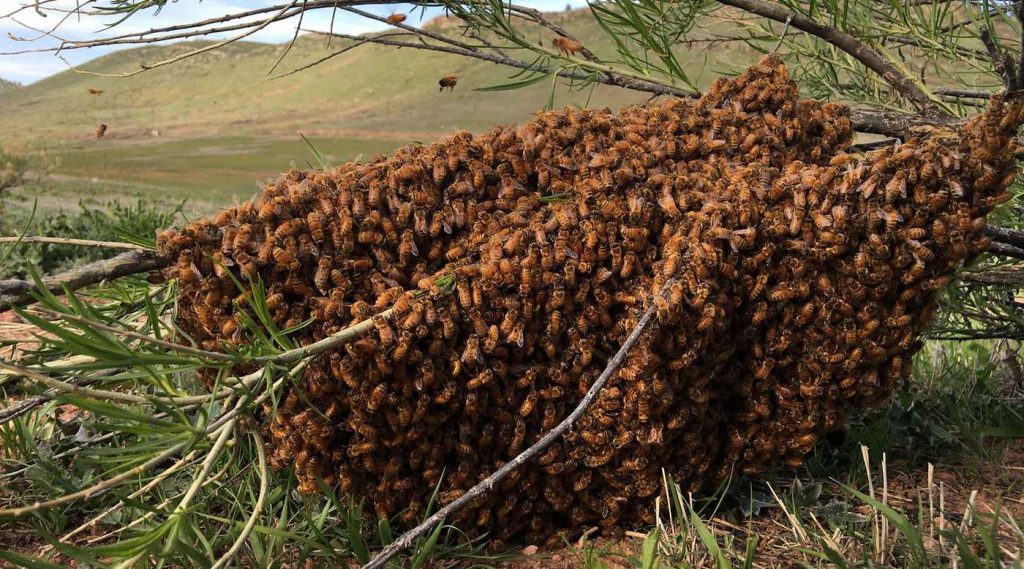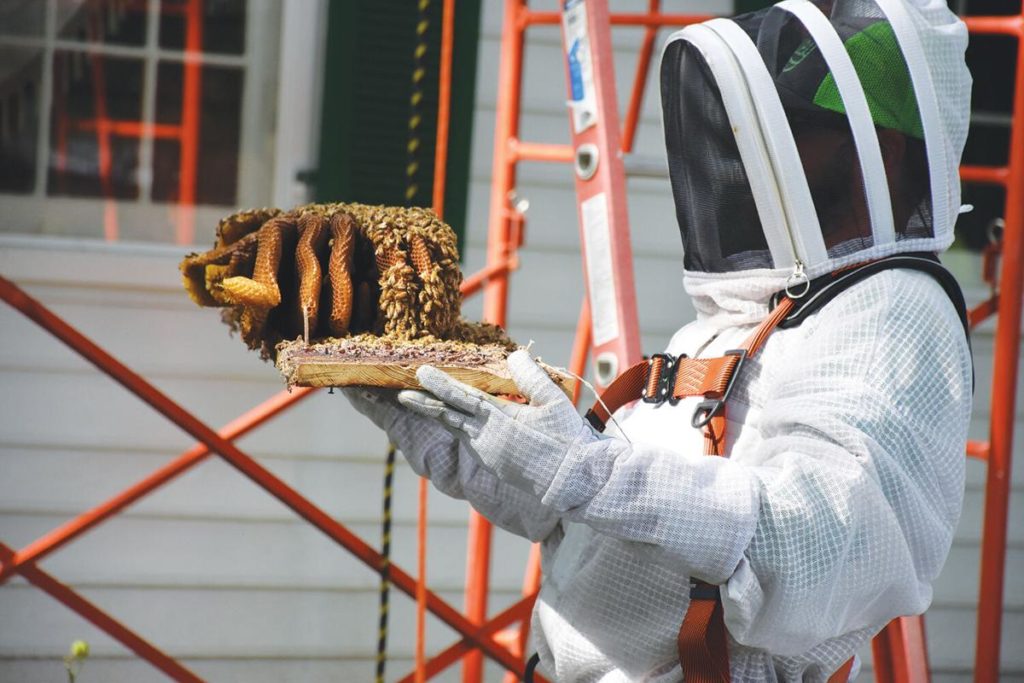Do you have a honeybee swarm or an established bee colony? First, let’s talk about the difference between the two so we can properly assist you:
Bee swarms are a natural phenomenon that occurs when a colony of bees reproduces by dividing into two or more groups. This typically happens in the spring or early summer when the colony’s population has grown and the hive becomes overcrowded. When a colony decides to swarm, a large portion of the worker bees, along with the old queen, leave the hive in search of a new location to establish a new colony. They form a cluster, usually on a tree branch or another suitable object, while scout bees search for a suitable nesting site.

There are several reasons why you should call a beekeeper if you encounter a bee swarm:
- Safety: While swarming bees are generally not aggressive, they can become defensive if they feel threatened. A beekeeper has the experience and equipment necessary to safely handle and relocate the swarm without harm to themselves or others.
- Protection of Bees: Honeybees play a crucial role in pollinating crops and wild plants, contributing to the biodiversity and productivity of ecosystems. By calling a beekeeper, you ensure that the swarm is captured and relocated to a new hive where they can continue their important work as pollinators.
- Prevention of Property Damage: Bee swarms can sometimes choose inconvenient locations for their temporary cluster, such as inside walls, attics, or other structures. If left untreated, this can lead to more significant problems, such as structural damage and the need for costly repairs. A beekeeper can safely remove the swarm before such issues arise.
- Environmental Stewardship: Supporting beekeepers in their efforts to manage and care for honeybee populations contributes to the conservation of these important pollinators. By calling a beekeeper to handle a swarm, you’re playing a role in protecting honeybee populations and promoting environmental stewardship.
Bee swarms are a natural part of the honeybee life cycle, and calling a beekeeper is the best course of action if you encounter one. By doing so, you ensure the safety of yourself and others, protect honeybees, prevent property damage, and support environmental conservation efforts.
The main difference between a bee swarm and a bee hive colony lies in their stages of development and behavior:
- Bee Swarm:
- A bee swarm is a temporary grouping of bees that occurs when a colony reproduces by dividing into two or more groups.
- Swarming typically happens in the spring or early summer when the colony’s population has grown and the hive becomes overcrowded.
- The swarm consists of a large portion of the worker bees, along with the old queen, leaving the hive in search of a new location to establish a new colony.
- Swarms are often found clustered together on a tree branch, fence post, or other object while scout bees search for a suitable nesting site.
- Swarms are usually temporary and do not have a permanent nest structure like a hive colony.
- Bee Hive Colony:
- A bee hive colony is a permanent grouping of bees that has established a nest in a suitable location, such as a hollow tree, cavity in a building, or specially constructed hive box.
- The colony consists of worker bees, drones (male bees), and a single queen bee, all working together to maintain the hive and carry out various tasks.
- The colony has a well-defined nest structure, consisting of wax honeycomb cells for storing honey, pollen, and brood (developing bees).
- The colony exhibits complex social behaviors, including foraging for food, caring for the brood, defending the hive, and communicating through intricate dances and pheromones.
- Hive colonies can persist for many years, with the queen laying eggs to replenish the worker bee population and sustain the colony’s existence.
Typically a bee hive colony removal will have a cost associated with removing live bees from within a structure. This is typically not a free service (unlike removing a swarm from a branch or fence post) since it will require a tear out of a wall, floor, soffit, roof, or structure. This will also require a professional contractor to replace or repair what was opened up. Most beekeepers are not capable or insured to do home remodels/repairs so please keep this in mind if you need to have a colony removed to also call a contractor to quote you for the repair once the bees are removed. Many beekeepers work with contractors to help assist them in the removal of honeybee colonies.

LIST OF BEEKEEPERS WHO DO SWARM & COLONY REMOVALS:
Tom Babcock – (443) 754-0151 Swarms tbabcock0001@gmail.com Whaleyville, Berlin
Aaron Sadberry – (443) 397-4797 SWARMS AND IN STRUCTURE / HOUSE REMOVALS Asadberry2023@gmail.com – Wicomico and Worcester County
Crystal Lehmanking– (443) 614-3609 Swarms Wicomico County – Email: a.mellifera.a@gmail.com
Victor – Swarms and trap outs for colony removals Victorkulynycz@gmail.com 410-725-2208
Jim Leether – Swarms and Colony Removals (443) 944-4840 · https://beesarefun.com/ Crisfield, Princess Anne, Salisbury, Pocomoke
Fred (and Lauren) Kelly – Swarms 410-357-1184 or Fred@baybeeshoney.com Ocean City, Ocean Pines, Berlin, Salisbury Colony removal ONLY with contractors assistance.
Brian and Cindy Hildreth – SWARMS – 443-235-8799 Salisbury, Eden, Fruitland, Princess Anne, (Wicomico and Somerset County)
Being a volunteer-run organization means that everyone involved has other commitments and may not always be immediately available. It’s essential to recognize and respect the time and effort that each member contributes to the organization and the bees, knowing that they are balancing their volunteer work with other responsibilities such as employment, family, and personal commitments.
IF YOU WOULD LIKE TO BE ADDED TO OUR SWARM COLLECTORS LIST, Please contact us with the following information: Your name and contact info, be sure to include what areas you would like to cover, swarm and or colony removals, and yearly LESBA Membership dues are paid to club before updated to the site. This site was updated and is current for Spring 2024 Swarm Season.
